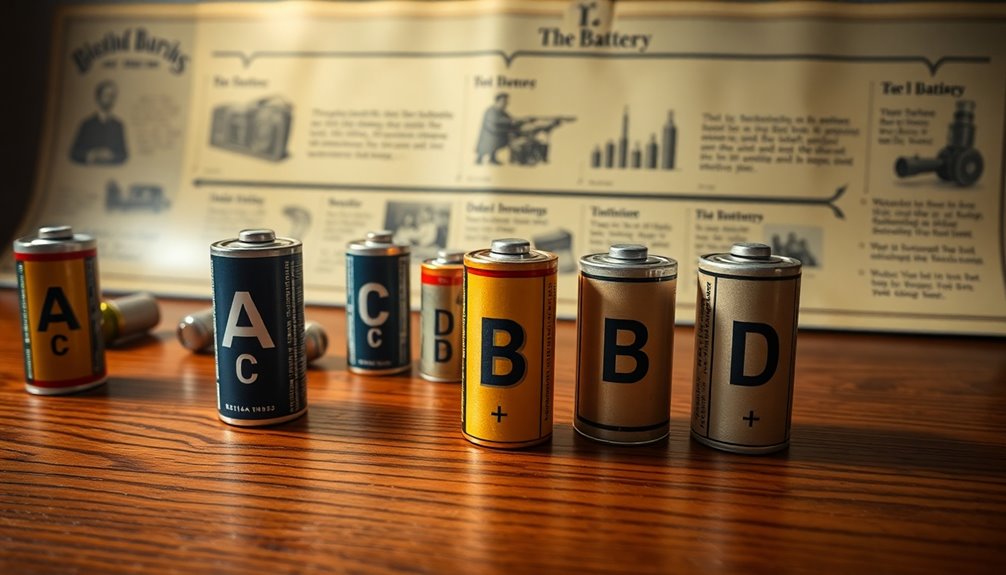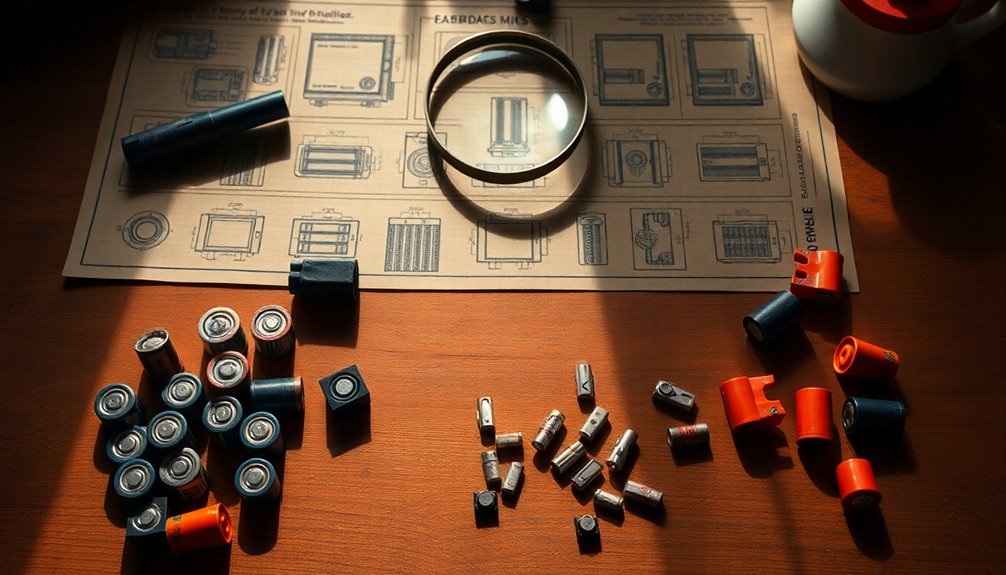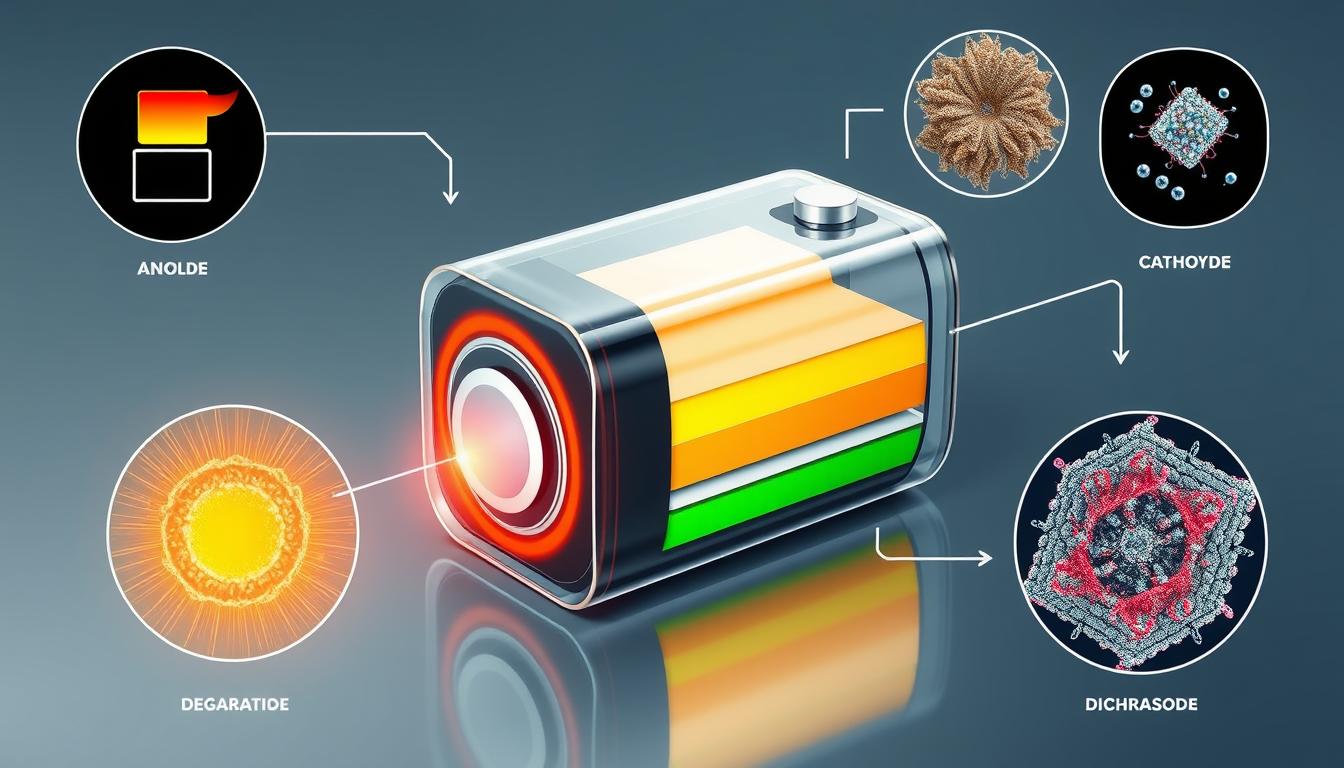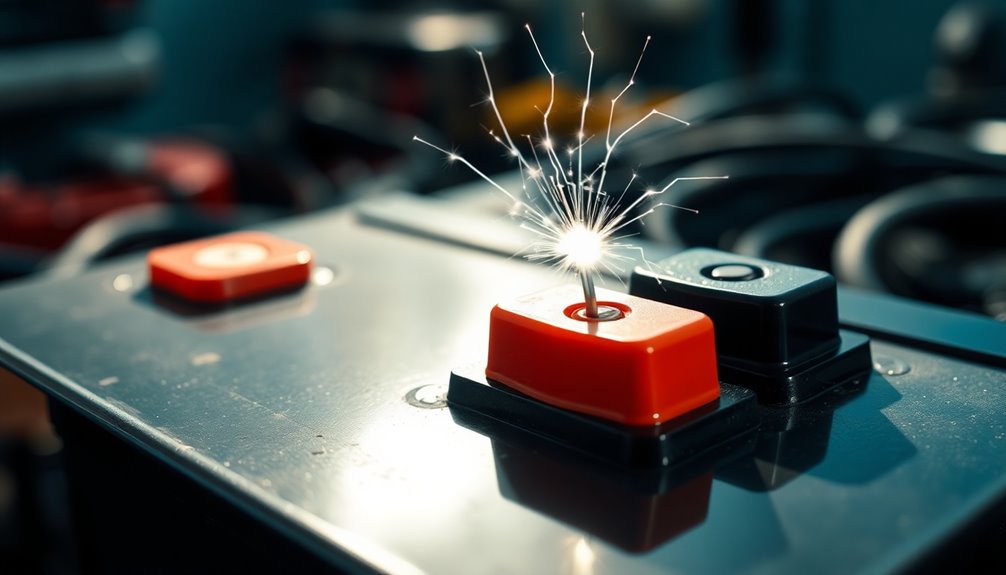You might wonder why B batteries seem to have disappeared. They once occupied shelves alongside other battery sizes, but market demand shifted towards more popular options like AA and AAA. This change led to the standardization of battery sizes during the 1920s, which favored larger capacities that consumers preferred. Although B batteries are still produced for niche uses, such as specialized electronics, their consumer visibility has dwindled. Technological advances and the rise of rechargeable options have further sidelined them. If you're curious about the broader implications of this change, there's much more to explore about battery technology and its evolution.
Key Takeaways
- B batteries have declined in popularity due to consumer preference for more versatile and compact sizes like AA and AAA.
- Standardization in the 1920s categorized battery sizes, leading to the overshadowing of B batteries by more common types.
- B batteries measure 21.5 mm x 60 mm, producing 1.5 volts, but are less visible in retail due to low consumer demand.
- Specialized applications, such as early laptop battery packs, still require B batteries, but overall market demand is limited.
- Technological advancements and a shift towards rechargeable batteries have further diminished the presence of B batteries in consumer electronics.
History of Battery Invention

When you explore the history of battery invention, you'll discover that the journey began in 1800 with Alessandro Volta's groundbreaking creation. This first true battery consisted of stacked zinc and copper discs separated by salt-water-soaked cloth.
Fast forward to 1868, and Georges Leclanché introduced a new battery type using ammonium chloride, enhancing performance and versatility.
In 1899, Waldemar Jungner further revolutionized the field with the nickel-cadmium battery, a significant leap for rechargeable battery technology.
The development of the dry battery by Carl Gassner also played a vital role, making batteries more portable and user-friendly by preventing spillage.
Each of these innovations paved the way for the diverse battery types we rely on today.
Standardization of Battery Sizes

The evolution of battery technology naturally led to the standardization of battery sizes, which gained momentum around World War I. The War Industries Board recognized the need for consistent specifications for battery cells, pushing for a unified approach.
In 1924, a meeting established a naming system, introducing classifications like A, B, C, and D, with "No. 6" becoming a standard due to its popularity. By 1928, the American Standards Association adopted this battery size list, solidifying the classification system you see today.
While sizes like AA and AAA became widely used, B batteries struggled for commercial viability, resulting in their diminished presence. This standardization laid the groundwork for future battery developments, prioritizing popular sizes over others.
The Rise of Popular Sizes

When you think about battery sizes, AA and AAA probably come to mind first, and there's a good reason for that.
These sizes took over the market due to their versatility and impressive capacity, pushing B batteries into the background.
As consumer preferences shifted, the dominance of AA and AAA became clear, leaving less room for other options.
Popularity of AA Batteries
Although battery technology has evolved considerably over the years, AA batteries remain the go-to choice for many consumers due to their perfect balance of power and size.
Introduced in the 1900s, AA batteries quickly gained popularity because they provide 1.5 volts and around 2700 mAh, sufficient energy for devices like remote controls and cameras.
The emergence of the AAA battery in 1959 offered a smaller alternative, yet the AA size continued to dominate the market.
As portable electronics surged in demand, manufacturers concentrated on producing AA and AAA batteries, leading to a decline in less common sizes like B and A batteries.
The ANSI standardization in the late 1920s solidified the AA battery's status, ensuring its widespread adoption in various applications. Additionally, the rise of renewable energy sources has spurred interest in sustainable battery solutions to complement traditional battery technologies.
Market Trends in Sizes
With AA and AAA batteries dominating the market, it's clear that consumer preferences have shifted dramatically over the years. The rise of popular battery sizes has streamlined production and consumer choice.
Here are key trends influencing this shift:
- Widespread Use: AA and AAA batteries are essential for most consumer electronics.
- Decline of B Batteries: Despite being standardized, B batteries have seen dwindling demand.
- Introduction of AAA: Launched in 1959, AAA batteries further reduced the market for B sizes.
- Focus on Viability: Manufacturers prioritize commercially viable battery sizes, sidelining older options.
As a result, battery sizes have evolved to meet consumer needs, leaving less popular options like B batteries behind. Additionally, this trend mirrors the concept of asset diversification, where focusing on a few popular options can enhance overall market stability.
Current Availability of B Batteries

Why are B batteries often overlooked in today's market?
Despite their compact size of 21.5 mm x 60 mm and a powerful output of 1.5 volts and 8350 mAh, B batteries don't enjoy the same popularity as AA and AAA batteries.
Their specialized applications, like early laptop battery packs, keep them in production, but you won't find them lining retail shelves.
The market's focus on more consumer-friendly sizes has diminished B batteries' visibility and usage.
While you may struggle to find them at your local store, rest assured they're still manufactured to meet specific needs.
Understanding Battery Classifications

When you think about battery classifications, it's fascinating to see how they've evolved over time.
The alphabetical system, established by the American Standards Association, highlights the popularity of certain sizes, like AA and AAA, while leaving others, like the B battery, behind.
Understanding this historical context helps explain why some sizes dominate the market today.
Historical Context of Classifications
Although the battery classification system was established in 1924, the absence of B batteries in the modern market raises questions about historical consumer preferences and technological advancements.
The system initially included sizes labeled alphabetically, but several factors led to the decline of B batteries:
- Consumer preferences shifted towards more compact options, like AA and AAA.
- The No. 6 battery maintained popularity despite standardization.
- Technological advancements in battery design overshadowed the original classifications.
- B batteries, while still produced, cater to niche markets due to their compact power efficiency.
These developments reflect how standards can evolve over time, often leaving older classifications behind as innovation drives consumer demand.
Understanding this context helps you appreciate the current landscape of battery sizes.
Popularity of Standard Sizes
The landscape of battery classifications has evolved markedly since the system's inception in 1924, leading to the dominance of standard sizes like AA and AAA. These sizes gained popularity due to their versatility and widespread use in everyday devices.
Introduced in 1959, the AAA battery quickly joined the ranks of AA, C, and D as the most commonly used batteries today. While B batteries, capable of producing 1.5 volts with an impressive capacity of 8350 mAh, are still manufactured, they never became commercially viable for consumer markets.
The American Standards Association's adoption of a battery size list in 1928 further solidified the preference for sizes like AA and AAA, cementing their status in our daily lives.
Current Market Availability
While many consumers rely on a few standard battery sizes, understanding the broader landscape of battery classifications reveals why options like B batteries remain scarce in the market.
B batteries, despite their compact power efficiency, haven't gained traction in mainstream use. Here's a quick breakdown:
- AA, AAA, C, and D batteries dominate the consumer market.
- The classification system was established in the 1920s when government agencies got together.
- B batteries have limited commercial viability, primarily serving niche applications.
- The rise of AAA batteries in 1959 further pushed B batteries out of favor.
Although B batteries are still produced, their decline reflects changing consumer preferences and the evolution of battery technology.
Lesser-Known Battery Variants

As technology evolves, lesser-known battery variants like B and F batteries continue to play crucial roles in specific applications.
B batteries, while less commercially viable, are still produced and offer dimensions of 21.5 mm x 60 mm, providing a voltage output of 1.5 volts and a capacity of 8350 mAh. Their compact power efficiency makes them suitable for certain devices, even if they're limited in consumer markets.
Meanwhile, A batteries, which are still in production, maintain a niche market for early laptop packs.
F batteries, often found in supermarkets, are rectangular 6-volt batteries serving specific needs and remain in active circulation.
These lesser-known batteries are still essential due to ongoing technological advancements and specific consumer demands.
Impact of Consumer Demand

How has consumer demand shaped the battery landscape? Your preferences have driven manufacturers to focus on AA and AAA batteries, leaving B batteries behind.
The American National Standards Institute's early categorizations created a framework, but as technology evolved, so did your needs.
Here are four ways consumer demand impacted battery production:
- Preference for compact, high-capacity batteries.
- Shift toward rechargeable options for convenience.
- Increased use of smaller devices requiring efficient power sources.
- Limited sales of B batteries, resulting in reduced availability.
As a result, B batteries became less compatible with modern electronics, diminishing their presence in the market.
Ultimately, your choices have led to the rarity of B batteries today.
Future of Battery Technology

With the rapid pace of technological advancements, the future of battery technology looks promising and transformative.
You'll see improvements in energy density, particularly with lithium-ion and solid-state batteries, offering longer lifespans and higher capacities.
Research into sodium-ion and lithium-sulfur batteries is set to reduce our reliance on scarce materials like cobalt, enhancing sustainability.
The surge in electric vehicles has fueled significant investments, leading to innovations in fast-charging and thermal management systems that enhance safety and efficiency.
Smart battery management systems are on the rise, optimizing charging cycles to extend battery life.
Collaboration among governments, private companies, and research institutions is essential to establish new standards and regulations, shaping the future landscape of battery technology.
Frequently Asked Questions
What Happened to B-Size Batteries?
B-size batteries have largely faded from the consumer market due to their limited commercial viability.
They just couldn't compete with the more popular AA and AAA sizes, which offer better efficiency and versatility.
While they still exist for specific uses in certain electronic devices and industrial applications, you'll find them much less frequently in everyday life.
The evolution of battery technology has shifted focus to sizes that better meet modern demands.
Can You Still Buy B Batteries?
You'd think finding B batteries would be a breeze, right?
Well, not exactly. While they're still produced, you won't spot them on store shelves much anymore.
They've become a rare gem, mostly reserved for specialized industrial or vintage devices.
If you really need them, try online retailers or specialty shops, but don't expect to find them in your local electronics aisle.
The world's just moved on to AA and AAA instead.
Are There Such Things as B Batteries?
Yes, there are B batteries! They exist with standard dimensions of 21.5 mm in diameter and 60 mm in height.
You'll find they output 1.5 volts and have a capacity of around 8350 mAh, making them efficient for specific applications.
However, they're not commonly used in consumer electronics, as most people prefer AA and AAA sizes.
While B batteries are available, their limited popularity means you won't see them in most retail stores.
Is There Such a Thing as a B Battery?
Picture a small, cylindrical powerhouse, measuring just 21.5 mm wide and 60 mm long.
Yes, there's such a thing as a B battery, though you won't see it on store shelves often. It packs 1.5 volts and boasts a capacity of 8350 mAh, perfect for niche applications.
While overshadowed by AA and AAA, B batteries remind you of the ever-evolving world of technology and changing consumer preferences.
Conclusion
Isn't it funny how you've probably never needed a B battery, yet here we are, diving deep into its mystery? While the world standardized battery sizes, the whimsical nature of consumer demand led to the rise of A and C batteries instead. As technology evolves, who knows what might come next? Maybe someday, you'll stumble upon a gadget that actually requires a B battery, making this little exploration all the more entertaining!










